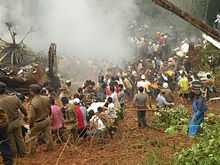Air India Express Flight 812 was a scheduled passenger service from Dubai to Mangalore, which, at around 01:00 UTC on 22 May 2010, overshot the runway on landing, fell over a cliff, and caught fire, spreading wreckage across the surrounding hillside.Of the 160 passengers and six crew members on board, only eight passengers survived.
With its 158 fatalities, the accident was the third deadliest aviation disaster in India, after the 1996 Charkhi Dadri mid-air collision, which killed 349, and the 1978 crash of Air India Flight 855, which killed 213. It marked the first major Indian aviation accident since the July 2000 crash of Alliance Air Flight 7412 in Patna. The accident is the deadliest crash of a 737 aircraft (all series) and the eighth hull loss of a Boeing 737-800 aircraft. The crash caused the highest number of aviation fatalities in 2010 and was the second of the year to involve a 737-800.
It was the second time that an aircraft had overshot a runway at Mangalore.Flight
The flight departed Dubai International Airport at 01:06 GST (21:06 UTC). It crashed upon landing at Mangalore International Airport at 06:05 IST (00:35 UTC). Situated in a hilly area, the airport is one of seven Indian airports designated as a "critical airfield" by the Directorate General of Civil Aviation (DGCA). DGCA rules at critical airfields prohibit "supervised take offs and landings", so that only the captain (not the first officer) may pilot an aircraft during take-off and landing. The airport is one of three airports in India having table top runways (the others being Kozhikode and Lengpui) that require heightened awareness and a very precise landing approach.
Crash
After touching down on the 8,033-foot (2,448 m) runway 24, the plane overran and crashed down the hill at its far end.[10] The final conversations between Air traffic control (ATC) and the pilot prior to the landing showed no indication of distress.
The then Civil Aviation Minister, Praful Patel said that the aircraft was following an Instrument landing system (ILS) approach for landing on the newer, longer, runway, which was commissioned in 2006. The pilot reported to ATC that it was 'established' on an ILS approach about 4.3 miles (6.9 km) from touchdown; landing clearance was then given at 2,000 feet (610 m) from touchdown. The aeroplane concluded its ILS approach on runway 24, touching down 5,200 feet (1,600 m) from the start of the runway, leaving 2,800 feet (850 m) in which to stop. It overran the runway and ploughed through a 90-metre (300 ft) sand arrestor bed which did not stop it. As the aircraft passed the arrestor bed, its starboard wing collided with the concrete socket of the ILS localiser antenna; it finally plunged over the edge of the table-top about 790 feet (240 m) beyond the end of the runway and down the steep hillside coming to a stop 660 to 980 feet (200 to 300 m) metres past the top of the slope.
"The plane broke in two" said one survivor "and a dense black smoke invaded the cabin. I jumped out through an opening in the window. Six other passengers followed me. We fled, with the help of the inhabitants of the nearby village". Television footage from shortly after the crash showed the remains of the aircraft on fire and lying on its belly with smoke rising from the wreckage. The minister also stated that weather conditions were normal with a visibility of 3.7 miles (6.0 km), and said wind conditions were calm and there was no rain at the time of the crash. A drizzle started only after the accident.
Rescue and response
Local villagers were among the first on the scene to help while an estimated 15 fire trucks, 20 ambulances and 100 rescue workers were immediately allocated to rescue operations. Karnataka Western Range Inspector General of Police, Gopal Hosur, said that eight to ten people had been moved to hospitals, and that the Karnataka Police force, bomb squad, Karnataka Fire and Emergency Services, Karnataka State Reserve Police and all hospitals were working together to help out. The Central Industrial Security Force (CISF) sent 150 personnel to Mangalore to help in the relief and rescue operations. Bodies of all of the deceased were recovered from the crash site on the day of the crash, with relatives of the deceased receiving 87 of the bodies.
After the rapid establishment of a special emergency information service, Praful Patel, Indian Civil Aviation minister, arrived from New Delhi to be at the scene and the one-year-in-office celebrations of the UPA government's second tenure were postponed. Patel was soon followed by Karnataka Chief Minister B. S. Yeddyurappa and Kerala Chief Minister V. S. Achuthanandan to take control of the situation. The chairperson of the governing UPA, Sonia Gandhi issued a message of grief and wished a "speedy recovery" to all. The Indian Minister for Civil Aviation, Praful Patel, took moral responsibility for the accident and offered to resign his post, an offer rejected by the Prime Minister of India, Manmohan Singh. Many countries and organisations expressed sorrow and condolences to the people of India over the crash. The accident was predicted to cost the insurers, and their reinsurers ₹4 billion (US$60 million). Air India's insurance company paid out ₹900 million (US$10 million) in settlement of the hull loss, and the company had already received ₹1.38 billion (US$20 million), that is 60 per cent of the estimated ₹2.3 billion (US$40 million). School of social Work, roshni nilaya conducted a study on Psychosocial Support for Survivors and Families of the Victims of Mangalore Air Crash to give the psyco-emotional support.



No comments:
Post a Comment